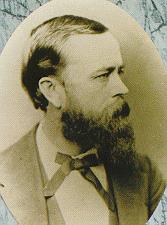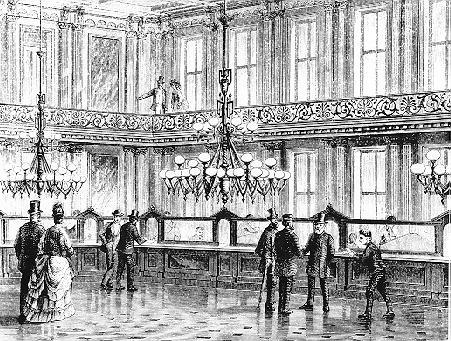
The Cash Room opened in June 1869 in the United States Treasury Department for the transaction of the government's financial business. The need for a bank in the Treasury Building arose indirectly from a reform of the country's monetary system in 1846 and from subsequent developments during the Civil War.
The architect of the Cash Room, Alfred B. Mullett, designed it as a roofed version of an Italian palazzo, a traditional bank design throughout Europe.
Mullett had admired the rich marble work he saw in European palaces and cathedrals during an architectural tour of the continent in 1865, and these impressions may have also influenced his design of the Cash Room.
Prior to it completion as a bank, the Cash Room was chosen as the site for the Inaugural Reception for President Ulysses S. Grant on March 4, 1869. Two thousand invitations were sold, each admitting one gentleman and two ladies. Unfortunately, lack of planning to control the crowd of six thousand turned the event into a disaster.

According to a report the next day in the Evening Star there was a "wild hunt for overcoats," as hats and overcoats had been jumbled together in the fourth-floor cloakroom without regard for a number system. Gentlemen had to wait in the corridors for hours to retrieve their garments. Others were forced to leave without wraps, only to return the next day to try again.
When the Cash Room opened officially in June it functioned principally as a "banker's bank," supplying area commercial banks with coins and currency f rom Treasury vaults and handling the government accounts of the District of Columbia. Services were also offered to the public, including cashing of government checks, exchanging new money for old, redeeming silver certificates and gold certificates, and selling U.S. Treasury bonds.
Up until the early 1900s, gold, silver, and paper currency were delivered to the Treasury Building in horse-drawn vans and unloaded at the sidewalk entrance on Fifteenth Street, then hauled through corridors on hand-carts and deposited on a cargo lift, the first elevator in the building, which carried them to the Cash Room vaults. Several million dollars might be contained in the vaults at any given time; bags of notes, coins, and bullion were stacked floor to ceiling.
Changes made to modernize and meet the demands posed by the great numbers of patrons were not always attractive, and they contributed to a general deterioration in the appearance of the room that occurred over years of wear and tear. By the 1970s, the costs of operating the Cash Room and maintaining its staff and security could no longer be justified. The Cash Room closed on June 30, 1976.

In 1985 a renewed appreciation of the Cash Room's historic significance enabled the Treasury Department to begin restoration. With a combination of federal support and private funds raised by the Committee for the Preservation of the Treasury Building, the room was slowly returned to its former splendor. The bronze gaslight chandeliers, which had apparently been scrapped around 1890 at the time electricity was introduced into the building were replicated from numerous historic photographs, including photographs taken by the Matthew Brady Studio around 1870.
Original wooden doors, transoms, and radiator-grill covers were replicated to replace stylistically inappropriate modern substitutes. Due to excessive wear, the remains of the original floor could not be restored, so a new floor was laid in the original pattern and materials, red Lisbon and Italian Carrara marble.
ACKNOWLEDGEMENTS: We appreciate the help of the Office of the Curator is providing and maintaining this information.
